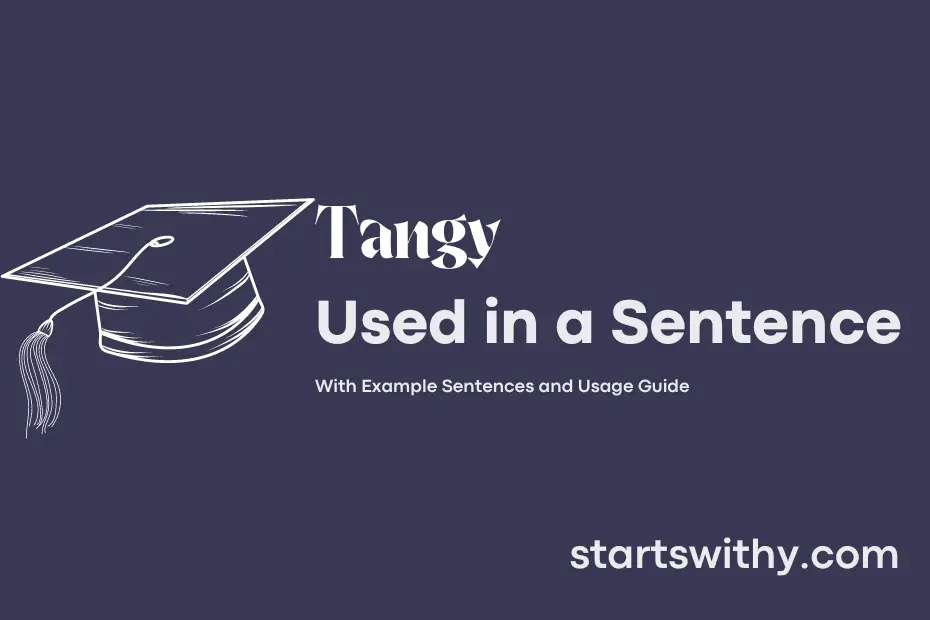Have you ever bitten into a piece of fruit that was both sweet and slightly sour? That delicious contrast is what creates the tangy flavor that can be found in various foods and beverages.
“Tangy” describes a sharp, zesty taste that adds a refreshing kick to your palate. This flavor profile is often associated with citrus fruits like lemons and limes, as well as fermented products such as pickles and yogurt.
7 Examples Of Tangy Used In a Sentence For Kids
- Tangy oranges are very juicy and delicious.
- I like to eat tangy pickles with my lunch.
- The lemonade at the party was very tangy.
- My mom made a tangy chutney to go with our dinner.
- Do you like the taste of tangy tamarind?
- The tomato sauce was a little too tangy for my liking.
- Let’s try some tangy yogurt for dessert.
14 Sentences with Tangy Examples
- Tangy snacks are perfect for late-night study sessions.
- I love adding a tangy chutney to my sandwich for an extra kick.
- A refreshing glass of tangy lemonade is great for staying hydrated during lectures.
- Tangy masala fries are a popular street food choice among college students.
- I enjoy experimenting with different tangy salad dressings for a healthy meal option.
- A bowl of tangy yogurt is a quick and easy breakfast option before class.
- Tangy tamarind candy is a favorite snack to munch on between lectures.
- A tangy salsa can elevate any boring meal into a flavorful experience.
- I always reach for a pack of tangy chips when I need a quick snack during a break.
- Tangy mint chutney is a must-have accompaniment with Indian street food favorites.
- Adding a tangy sauce to my noodles gives them a delicious twist.
- I love the burst of flavors in a tangy fruit salad during hot summer days.
- A tangy pickle adds a zesty touch to any simple meal of rice and lentils.
- I enjoy a slice of pizza with a tangy sauce drizzled on top for an extra punch of flavor.
How To Use Tangy in Sentences?
Tangy is a word that is used to describe a sharp, acidic, or sour flavor in food. When using Tangy in a sentence, it is important to consider the context in which it is being used.
Here are some tips on how to use Tangy in a sentence:
-
Tangy is an adjective that is often used before a noun to describe the taste of a food. For example, “The salad dressing had a tangy flavor that added a refreshing kick to the dish.”
-
You can also use Tangy to describe a food or flavor profile in a more general sense. For instance, “The salsa had a tangy kick that paired well with the spicy nachos.”
-
Tangy can also be used metaphorically to describe a person’s personality or attitude. For example, “Her tangy remarks left a lasting impression on everyone at the meeting.”
-
Remember to always follow Tangy with a noun to provide context and convey the intended meaning. Without a noun to modify, tangy may be unclear or confusing in a sentence.
By keeping these tips in mind, you can confidently incorporate Tangy into your vocabulary and express yourself effectively when discussing flavors, food, or even personalities.
Conclusion
In conclusion, sentences with the keyword “tangy” often describe flavors that are sharp, zesty, or slightly sour. These sentences help paint a vivid picture for readers by invoking the sensory experience of tasting something tangy, such as a ripe citrus fruit or a tangy salad dressing. By incorporating the word “tangy” into descriptions, writers can effectively convey the unique and refreshing taste sensations that accompany this flavor profile.
Whether it’s a tangy marinade adding a burst of flavor to grilled chicken or a tangy salsa providing a bright contrast to savory tacos, sentences with “tangy” effortlessly bring a mouth-watering element to any written composition. By leveraging the power of this descriptive term, writers can enhance their prose and engage readers’ senses in a memorable and evocative manner.



